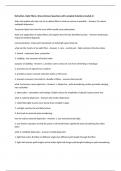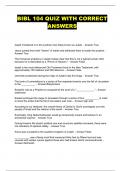Exam (elaborations)
Refraction, Optic Fibres, Waves Review Questions with complete Solutions Graded A+
- Course
- Institution
Refraction, Optic Fibres, Waves Review Questions with complete Solutions Graded A+ State and explain why the core of an optical fibre is made as narrow as possible. - Answers To reduce multipath dispersion To prevent data loss from the core which would cause attenuation. State one application of...
[Show more]




